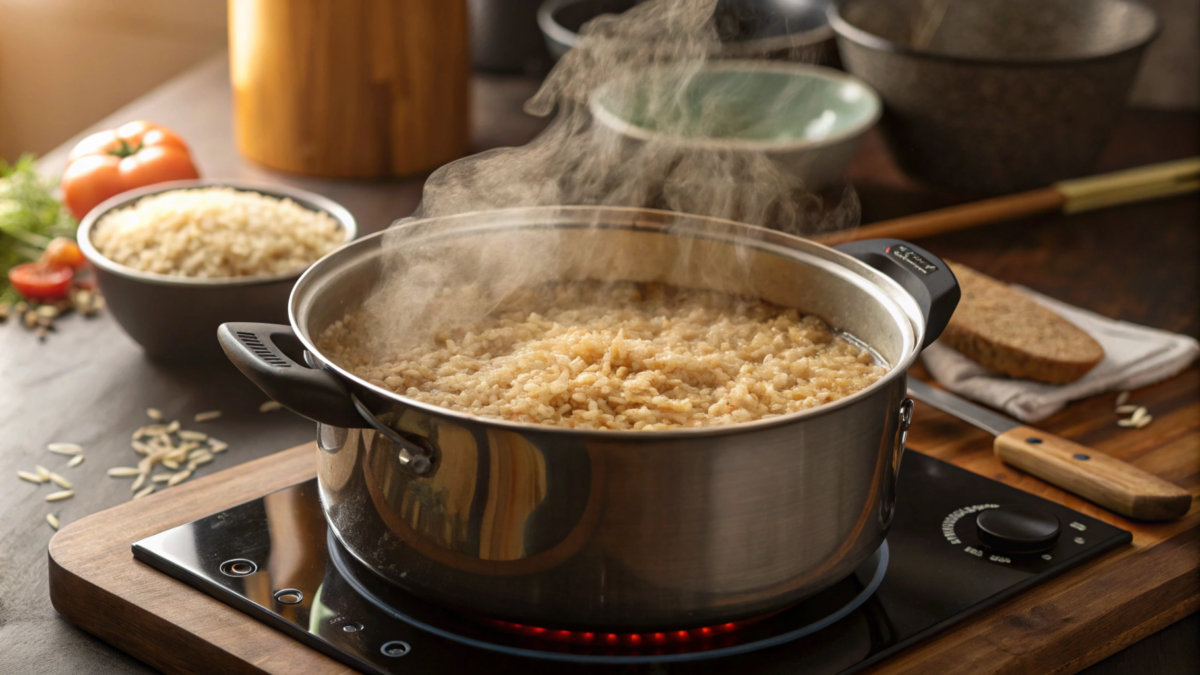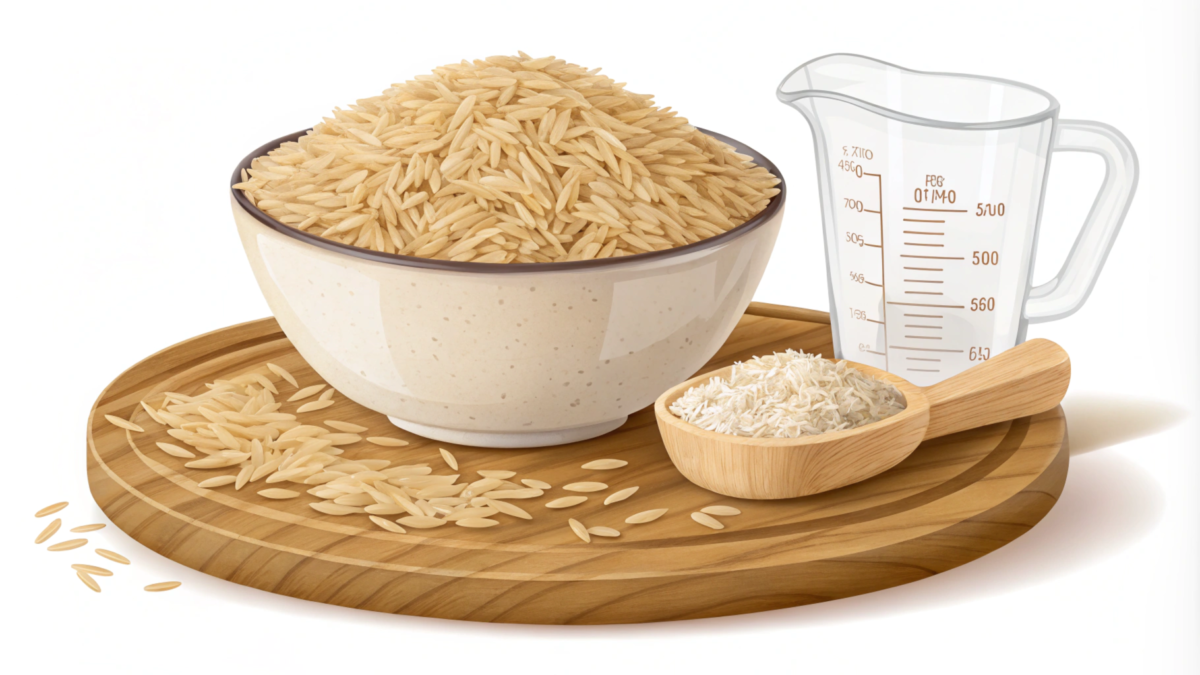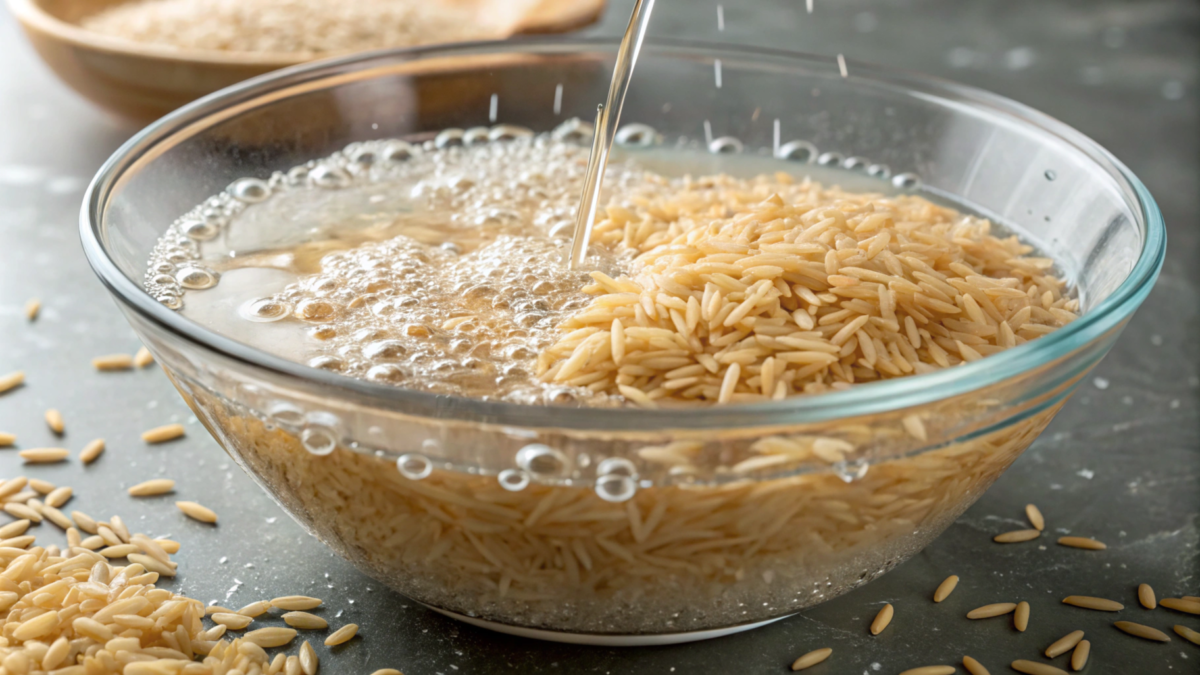Understanding Brown Basmati Rice
Cooking brown basmati rice often sparks a common question: Do I need to soak brown basmati rice before cooking? This guide explores the advantages, drawbacks, and techniques to help you decide whether soaking is worth the effort. Whether you’re a seasoned cook or a rice novice, you’ll uncover tips and tricks to master this wholesome grain. Let’s dive in!
What is Brown Basmati Rice?
Brown basmati rice is a whole-grain variety of rice that retains its bran and germ layers, making it richer in nutrients compared to its white counterpart. Known for its long grains and nutty aroma, this rice has roots in South Asia and the Middle East. Unlike white rice, which has been polished and stripped of its outer layers, brown basmati rice offers a chewy texture and a slightly earthy flavor.
Its standout feature is the intact bran, which contributes not only to its nutritional value but also to its unique texture. Because of this, cooking brown basmati rice often requires a bit more time and care. Whether you choose to soak brown basmati rice or not can significantly impact the final dish, from its texture to its digestibility.
Nutritional Benefits of Brown Basmati Rice
One of the biggest reasons to opt for brown basmati rice is its impressive nutrient profile. It’s a powerhouse of complex carbohydrates, fiber, vitamins, and minerals like magnesium and selenium. These nutrients support everything from digestion to heart health, making it a staple for health-conscious eaters.
Additionally, the rice has a low glycemic index, which means it’s ideal for managing blood sugar levels. That’s a win for those looking to maintain steady energy throughout the day! Pairing brown basmati rice with protein and vegetables makes for a perfectly balanced, wholesome meal.
For more about the nutritional benefits of brown rice, check out this detailed guide on brown rice benefits.
The next section dives into the age-old debate: Do I need to soak brown basmati rice before cooking? Stay tuned to uncover the pros, cons, and best practices for soaking this nutritious grain.
The Soaking Debate
The question Do I need to soak brown basmati rice before cooking isn’t just about tradition but also about science and personal preference
Do I Need to Soak Brown Basmati Rice Before Cooking?
Ah, the age-old question! Do I need to soak brown basmati rice before cooking? The answer isn’t as simple as a yes or no—it depends on personal preferences and the type of dish you’re preparing. Soaking is often recommended because it can enhance the rice’s texture, reduce cooking time, and even improve digestibility. However, it’s not strictly necessary, and some argue that skipping this step preserves the rice’s natural nuttiness.
To soak or not to soak ultimately boils down to tradition, science, and convenience. While soaking does require a bit of planning, the results can be well worth the effort for certain recipes. Let’s explore why soaking has been a common practice and whether modern science supports it.
Traditional Practices in Rice Preparation
In many cultures, soaking rice before cooking is a time-honored tradition. In South Asia, for instance, families often soak brown basmati rice for hours or even overnight before preparing fragrant pilafs or curries. This practice wasn’t merely a whim—it had practical and cultural significance.
Historically, soaking helped remove impurities from the rice, particularly when it was harvested and processed by hand. It also softened the tough outer bran layer, making the rice easier to cook and digest. The water absorbed during soaking allowed the grains to expand and become fluffier once cooked, a hallmark of perfectly prepared basmati rice.
Beyond the practical benefits, soaking was also seen as a way to honor the ingredient. It demonstrated care and respect for the food being prepared. Even today, traditional chefs argue that soaking enhances the aroma and taste of brown basmati rice in a way that’s hard to replicate without it.
Scientific Perspective on Soaking Rice
From a scientific standpoint, soaking brown basmati rice is about more than just tradition—it’s also backed by facts. The bran layer in brown rice contains phytic acid, an anti-nutrient that can inhibit the absorption of minerals like iron, zinc, and calcium. Soaking the rice can help reduce phytic acid levels, making these minerals more bioavailable and easier for the body to absorb.
Additionally, soaking hydrates the rice grains, which shortens cooking time by as much as 20-30%. This is particularly helpful when cooking brown basmati rice, which tends to require a longer cooking period than white rice. By pre-soaking, you can achieve tender, evenly cooked grains without risking overcooking the outer layers.
However, soaking also has its critics. Some argue that it can lead to a slight loss of water-soluble nutrients, such as certain B vitamins. While this is true to a degree, the nutrient loss is minimal compared to the benefits of enhanced digestibility and flavor.
For those in a hurry, soaking might feel like an unnecessary step, but understanding its scientific benefits can make it a game-changer for home cooks. If time allows, soaking brown basmati rice is a simple yet effective way to elevate your cooking.
The next section will explore the tangible advantages of soaking brown basmati rice, so keep reading to see why this practice might be worth incorporating into your routine!
Advantages of Soaking
Benefits of Soaking Brown Basmati Rice
Soaking brown basmati rice might seem like an extra step, but the rewards are plentiful. From improved texture to better nutrient availability, soaking can elevate your cooking and unlock the rice’s full potential. Let’s dive into the specific benefits that this simple yet effective process brings to your kitchen.
Improved Texture and Flavor
One of the most noticeable advantages of soaking brown basmati rice is the way it transforms the texture and flavor. By allowing the grains to absorb water before cooking, you ensure they expand uniformly. The result? A fluffier, softer rice with that signature basmati separation—no clumps or mushy spots to ruin the dish!
The soaking process also enhances the nutty aroma and subtle taste that make basmati rice so beloved. When the rice hydrates evenly, the flavors deepen, creating a more harmonious bite. This is particularly important for dishes like biryanis or pilafs, where the texture and taste of the rice are key to the overall success of the meal.
Reduced Cooking Time
For anyone pressed for time, soaking brown basmati rice can be a lifesaver. Brown rice typically takes longer to cook than white rice because of its bran layer. Soaking, however, cuts down cooking time significantly—sometimes by as much as 30%!
Pre-soaked rice cooks faster because the grains are already hydrated. This not only saves time but also reduces the chances of overcooking or burning the rice. Whether you’re preparing a quick weeknight dinner or meal prepping for the week, a shorter cooking time is always a win.
Enhanced Nutrient Absorption
The nutritional benefits of soaking brown basmati rice are often overlooked, but they’re a compelling reason to adopt this practice. Soaking reduces phytic acid, an anti-nutrient found in the bran layer that can block the absorption of essential minerals like magnesium and zinc.
By neutralizing phytic acid, soaking allows your body to absorb more of the rice’s natural nutrients. This is especially beneficial for those following plant-based diets, where maximizing nutrient intake is key. Think of soaking as a simple step to make this already nutritious grain even healthier.
Potential Drawbacks
Drawbacks of Soaking Brown Basmati Rice
While soaking brown basmati rice has many benefits, it’s not without its downsides. From slight nutrient loss to potential changes in texture, it’s important to weigh the pros and cons before deciding if soaking is right for you.
Nutrient Loss Concerns
One of the main arguments against soaking brown basmati rice is the potential for nutrient loss. Water-soluble vitamins, like some B vitamins, can leach into the soaking water and be discarded. While this loss is minimal, it’s something to consider if you’re trying to retain every bit of nutrition.
For those worried about this, a simple solution is to use the soaking water in cooking. Incorporating it into soups or stews ensures that you still benefit from those nutrients, while also adding a touch of extra flavor.
Changes in Texture
Another drawback of soaking is that it can slightly alter the texture of the rice. While most people prefer the softer, fluffier grains that soaking produces, some enjoy the firmer bite of unsoaked brown basmati rice. The choice largely comes down to personal preference.
In some cases, over-soaking can even lead to overly soft or mushy rice. Timing is key—soaking for too long may cause the grains to break apart during cooking, especially if they are agitated too much. Sticking to the recommended soaking time (generally 30 minutes to 1 hour) can help avoid this issue.
The next part will focus on how to soak brown basmati rice properly to maximize benefits while minimizing drawbacks. Let’s move on to the best practices!
Soaking Techniques
How to Properly Soak Brown Basmati Rice
Soaking brown basmati rice doesn’t have to be complicated. A few simple steps can make all the difference in the final outcome. Proper soaking not only enhances texture but also ensures even cooking. Follow these tried-and-true methods to get it just right.
Rinsing the Rice
Before soaking, always rinse your brown basmati rice thoroughly. Rinsing helps remove surface starches and impurities, which can otherwise cause the rice to become sticky or gummy during cooking.
To rinse, place the rice in a fine mesh strainer and run cold water over it. Gently rub the grains between your fingers as the water flows through. Keep rinsing until the water runs clear. This process ensures that the rice is clean and ready to absorb water evenly during soaking.
Rinsing is particularly important for brown basmati rice, as its outer layer can harbor residual husk or dust from processing. Taking this step ensures that every grain is pristine and ready for the next stage.
Optimal Soaking Duration
When it comes to soaking, timing is everything. For brown basmati rice, the sweet spot is usually 30 minutes to 1 hour. This duration allows the grains to absorb enough water to soften without becoming overly mushy.
Shorter soaking times are fine if you’re in a hurry, but the results might not be as consistent. On the other hand, soaking for too long—more than a few hours—can lead to overhydration, causing the grains to lose their shape during cooking.
For the best results, use a timer to avoid over-soaking. Once the rice has soaked, be sure to drain and rinse it again before cooking. This final rinse removes any excess starch released during soaking.
Water Temperature Considerations
Believe it or not, the temperature of the water you use for soaking can make a difference. Room-temperature water works well for most applications, allowing the rice to hydrate gradually. However, warm water (not hot!) can speed up the soaking process slightly if you’re short on time.
Avoid using cold water straight from the fridge, as it may slow down the absorption process. Similarly, boiling or overly hot water can damage the grains, making them brittle or unevenly cooked.
For consistent results, use lukewarm water and stir the rice gently to ensure even hydration. This approach strikes the perfect balance, giving you rice that’s ready to cook and full of flavor.
Cooking Methods
Cooking Brown Basmati Rice Without Soaking
While soaking offers many benefits, you can still cook brown basmati rice without soaking. The key lies in adjusting your technique to ensure that the grains cook evenly. With a bit of extra time and attention, unsoaked rice can be just as delicious.
Stovetop Method
For stovetop cooking, use a heavy-bottomed pot with a tight-fitting lid. Rinse the rice thoroughly before adding it to the pot with water. The ideal water-to-rice ratio for unsoaked brown basmati rice is 2.5 cups of water per cup of rice.
Bring the water to a boil, then reduce the heat to low and cover the pot. Let the rice simmer for 40–45 minutes, or until the water is fully absorbed. Once cooked, allow the rice to rest with the lid on for an additional 10 minutes before fluffing it with a fork.
Rice Cooker Method
A rice cooker can simplify the process of cooking unsoaked brown basmati rice. Add the rinsed rice and water in the same 2.5:1 ratio. Set the rice cooker to the “brown rice” setting or follow the manufacturer’s instructions.
Rice cookers are particularly convenient because they maintain consistent heat and turn off automatically when the rice is done. No need to hover over the stove—just let the machine do the work.
Instant Pot Method
For those who love pressure cooking, an Instant Pot is a game-changer. Add 1 cup of rinsed brown basmati rice and 1.25 cups of water to the pot. Seal the lid and set the Instant Pot to “Pressure Cook” on high for 22–25 minutes.
Once the timer goes off, allow the pressure to release naturally for 10 minutes before opening the lid. Fluff the rice gently, and you’re ready to serve! This method is perfect for busy cooks who need quick, consistent results.
Comparative Analysis
Soaked vs. Unsoaked Brown Basmati Rice
Now that we’ve covered both methods, how does soaked rice compare to unsoaked? The differences are subtle yet significant, affecting texture, flavor, and even nutritional value.
Texture Differences
Soaked brown basmati rice tends to have a softer, fluffier texture, while unsoaked rice is slightly firmer and chewier. If you prefer your grains to be light and airy, soaking is the way to go. For dishes requiring firmer rice, like stir-fries, unsoaked may be a better choice.
Flavor Profiles
Soaking enhances the nutty aroma and earthy flavor of brown basmati rice. The water absorption allows the grains to cook more evenly, which helps release their natural oils and flavors. Unsoaked rice, on the other hand, retains a slightly raw undertone, which some people might find appealing for certain recipes.
Nutritional Variations
Soaking reduces phytic acid, making soaked rice more nutrient-dense. However, minimal water-soluble vitamin loss occurs during soaking, which doesn’t happen with unsoaked rice. Both methods preserve the overall nutritional value, so the choice ultimately depends on personal preference and convenience.
In the next section, we’ll explore expert opinions and cultural practices surrounding brown basmati rice, offering further insights into this versatile grain!
Expert Opinions
Culinary Experts on Soaking Rice
The debate over soaking brown basmati rice has drawn opinions from culinary experts around the globe. While traditional chefs often advocate for soaking as a crucial step, modern cooks focus on its convenience and scientific merits. Let’s delve into what the experts have to say.
Traditional Chefs’ Perspectives
Traditional chefs emphasize soaking as a way to honor the rice and enhance its natural qualities. In many South Asian and Middle Eastern kitchens, soaking is non-negotiable. They believe it improves the rice’s texture, allows for more even cooking, and brings out its nutty aroma.
According to a well-known South Asian chef, soaking is “like breathing life into the rice.” They explain that hydrated grains expand gracefully during cooking, producing the iconic fluffiness and separation characteristic of basmati rice. For celebratory dishes like biryanis, where texture is paramount, skipping the soak is simply not an option.
Modern Culinary Views
Modern culinary experts often take a pragmatic approach to soaking rice. While they acknowledge its benefits, they argue that soaking isn’t always necessary—especially when time is limited. For busy home cooks, techniques like pressure cooking can deliver comparable results without the need to soak.
Some experts also caution against over-soaking, which can lead to mushy or overly soft rice. They recommend experimenting with soaking times to find what works best for individual preferences and specific recipes. In essence, they see soaking as a valuable, but not indispensable, tool in the kitchen.
Cultural Practices
Soaking Rice in Different Cultures
The practice of soaking brown basmati rice has deep roots in various culinary traditions. Different cultures approach this step with their unique methods and philosophies, reflecting the versatility of rice as a global staple.
South Asian Practices
In South Asia, soaking rice is steeped in tradition. Families often soak their brown basmati rice for at least 30 minutes, sometimes overnight, before cooking. This practice ensures that the grains remain fluffy and light, perfect for dishes like pulao and khichdi.
South Asian chefs also use soaking as an opportunity to infuse the rice with flavors. Spices such as cinnamon, cloves, or bay leaves are sometimes added to the soaking water, imparting subtle notes to the cooked grains.
Middle Eastern Traditions
In Middle Eastern cooking, soaking rice is common for dishes like kabsa and maklouba. The goal is to achieve a balance between tender rice and distinct grains. Some recipes call for soaking the rice alongside salt, which helps enhance its flavor and reduces cooking time.
Traditional Middle Eastern cooks often view soaking as a way to ensure consistency and elevate the dish’s overall quality. It’s considered a labor of love, particularly for festive meals or family gatherings.
Western Cooking Approaches
In Western cuisines, the practice of soaking rice is less common, but it’s gaining popularity among health-conscious cooks. Many Western recipes focus on the convenience of cooking without soaking, often using appliances like rice cookers or Instant Pots.
However, as awareness grows about the benefits of soaking—such as improved digestibility and enhanced flavor—more home cooks are beginning to incorporate this step into their routines. For dishes like rice salads or grain bowls, soaked rice offers a more tender and appealing texture.
Practical Tips
Best Practices for Cooking Brown Basmati Rice
Cooking brown basmati rice doesn’t have to be a guessing game. By following a few practical tips, you can ensure consistently delicious results every time. Let’s explore some expert-backed strategies.
Selecting Quality Rice
The quality of your brown basmati rice plays a crucial role in its final taste and texture. Look for rice that’s labeled as “aged,” as this ensures the grains are less likely to break during cooking and have a deeper, more complex flavor.
Inspect the packaging for uniform, long grains and avoid rice with too many broken pieces or an overly dusty appearance. Trusted brands like those endorsed by culinary experts or local farmers’ markets are excellent choices for sourcing high-quality rice.
Storage Recommendations
Proper storage is essential for maintaining the freshness of brown basmati rice. Store it in an airtight container in a cool, dry place to prevent exposure to moisture or pests.
For long-term storage, consider refrigerating or freezing the rice. This not only extends its shelf life but also preserves its nutty aroma. Always label your storage containers with the purchase date to keep track of freshness.
Flavor Enhancement Techniques
Elevate the flavor of brown basmati rice by incorporating a few simple techniques. Toasting the rice in a small amount of oil or ghee before cooking can enhance its nutty profile.
Additionally, cooking the rice in broth instead of plain water adds depth and richness. For a subtle aromatic twist, include whole spices like cardamom, cinnamon, or star anise in the pot. These little touches make a big difference, transforming ordinary rice into an extraordinary side dish.
Stay tuned for the conclusion, where we’ll tie together all the insights shared in this comprehensive guide to cooking brown basmati rice!
Frequently Asked Questions (FAQs)
Is it necessary to soak brown basmati rice before cooking?
Not necessarily! While soaking brown basmati rice has clear advantages like softer texture, faster cooking, and better nutrient absorption, it isn’t a must. Skipping soaking means your rice might take longer to cook and have a firmer texture, which some people prefer.
That said, soaking is highly recommended for dishes where fluffy, light rice is essential, such as biryanis or pilafs. If you have the time, it’s worth giving soaking a try to see how it transforms your rice’s texture and flavor.
How long should I soak brown basmati rice?
The ideal soaking time for brown basmati rice is between 30 minutes and 1 hour. This duration hydrates the grains adequately without over-softening them.
If you’re short on time, even a quick 15-minute soak can make a noticeable difference in cooking time and texture. However, soaking overnight isn’t advisable as it may cause the grains to become overly soft or lose their structure.
What happens if I don’t soak brown basmati rice?
If you skip soaking, your brown basmati rice will likely require a longer cooking time—typically around 40–45 minutes on the stovetop. The texture may also turn out firmer and chewier, which is great for some recipes like fried rice or grain bowls.
However, the lack of pre-hydration might result in unevenly cooked grains, especially if you’re not precise with your water-to-rice ratio. Skipping soaking also means missing out on some of the flavor and aroma enhancements that come with the process.
Does soaking brown basmati rice affect its nutritional value?
Yes, soaking can slightly affect the nutritional profile of brown basmati rice. While it reduces phytic acid—making minerals like magnesium and zinc more absorbable—it may also lead to a small loss of water-soluble vitamins, such as certain B vitamins.
The good news is that the nutrient loss is minimal and often outweighed by the benefits of easier digestion and enhanced flavor. To retain nutrients, you can use the soaking water in soups or stews.
Can I cook brown basmati rice in a rice cooker without soaking?
Absolutely! A rice cooker is a fantastic tool for cooking unsoaked brown basmati rice. Simply adjust the water-to-rice ratio to account for the lack of soaking. Typically, 2.5 cups of water per cup of rice works well.
Use the “brown rice” setting if your cooker has one, or follow the general cooking time for brown rice. While the results won’t be as fluffy as soaked rice, they’ll still be delicious and perfectly cooked.
What is the ideal water-to-rice ratio for cooking unsoaked brown basmati rice?
The ideal water-to-rice ratio for cooking unsoaked brown basmati rice is about 2.5 cups of water for every cup of rice. This extra water compensates for the hydration that soaking would normally provide.
For pressure cooking methods like an Instant Pot, reduce the ratio slightly to about 1.25 cups of water per cup of rice to avoid overcooking. Precision with the ratio ensures tender, evenly cooked rice every time.
Conclusion
Final Thoughts on Soaking Brown Basmati Rice
Soaking brown basmati rice might seem like a small step, but it has a big impact on the final dish. From enhanced texture and flavor to reduced cooking time and better nutrient absorption, the benefits of soaking are hard to ignore.
That said, it’s not a mandatory step. Skipping soaking is perfectly fine for certain dishes or when time is tight. With the right cooking methods and water ratios, you can still enjoy delicious, nutritious rice whether or not it’s been soaked.
Ultimately, the decision comes down to your preferences, the dish you’re preparing, and the time you have. Experiment with both methods to find what works best for your kitchen routine. Either way, brown basmati rice remains a versatile and wholesome choice for countless recipes. Enjoy the journey of cooking and savoring this beloved grain!



